you are here: mainpage > timeline
![]()
![]()
![]()
![]()
![]()
you are here: mainpage > timeline
pre history | antiquity | pre industrial era | industrial era
(a history of computers in a nutshell)
| Related Articles |
| all timelines |
| Related Resources |
|
pre history |
![]() The Universal
computer boots up with a Big Bang, everything that was has now become or will
be. ;=)
The Universal
computer boots up with a Big Bang, everything that was has now become or will
be. ;=)
![]() In the beginning,
mankind may not have had any idea of numerical units.
In the beginning,
mankind may not have had any idea of numerical units.
Possessions had to be portable, since they had to be carried around. Everything
that could not be carried, was left behind. People had to be quick in movement
and reaction; being slow meant instant death.
Animals were not the stuffy types we keep in zoos nowadays. They were bigger,
fast as lightning and regarded a human just as another piece of juicy meat.
And there were no gates or anything to keep them back. There for humans tended
not to have to carry too much around for their own safety.
One could safely say that the need to count or calculate was not present since
since possessions were scarce and little.
But when having gathered something, they surely could tell you that there
were less or more objects of, let's say, apples when apples were added or taken
away.
Could one presume that they were visualizing the form (pile of apples) and estimated
the size to have an idea of quantities? Was their way to tell something was
missing or added through observing that the form of the pile had changed? When
the pile of apples had become bigger, some apples were added. The bigger the
image they had in memory the more they had. Or at least this seems to be a logical
explanation of humans interfacing with their environment.
As time progressed, people migrated from a nomadic hunter-gatherer lifestyle into a domestic lifestyle. Occupied pieces of land and started farming. Hunting still took place but out from a permanent camp site.
The number of humans grew and they specialized in professions: shoemakers, farmers, black smiths... In time wealth and other things started to accumulate and volumes became larger.
Methods of visualizing quantities are of course very subjective, the need for better means of telling quantities and at the same time keeping track of them, increased. And as always the means were invented or improved upon when needed.
![]() The first
tools used for calculation aids were almost certainly man's own fingers, and
it is no coincidence that the word "digit" is used to refer
to a finger (or toe) as well as a numerical quantity.
The first
tools used for calculation aids were almost certainly man's own fingers, and
it is no coincidence that the word "digit" is used to refer
to a finger (or toe) as well as a numerical quantity.
As the needed to represent larger numbers grows, early man employed readily available materials for the purpose. Small stones or pebbles were used to represent larger numbers than fingers and toes, that had the added advantage of easily storing intermediate results for later use. Thus, it is no coincidence that the word "calculate" was derived from the Latin word for pebble: calculus.
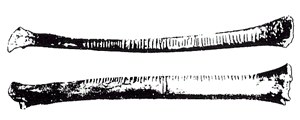
![]() The oldest
known objects used to represent numbers were bones with notches carved into
them, see picture above. These bones, which were discovered in western Europe,
date from the Aurignacian period 20,000 to 30,000 years ago and correspond to
the first appearance of Cro-Magnon man. (Named "Cro-Magnon"
after the caves of the same name in Southern France, in which the first skeletons
of this race was found in 1868.). Of special interest is a wolf's jawbone more
than 20,000 years old with fifty-five notches in groups of five, which was discovered
in Czechoslovakia in 1937. This is the first evidence of the tally system,
which is still used occasionally to the present day and could therefore qualify
as one of the most enduring of human inventions.
The oldest
known objects used to represent numbers were bones with notches carved into
them, see picture above. These bones, which were discovered in western Europe,
date from the Aurignacian period 20,000 to 30,000 years ago and correspond to
the first appearance of Cro-Magnon man. (Named "Cro-Magnon"
after the caves of the same name in Southern France, in which the first skeletons
of this race was found in 1868.). Of special interest is a wolf's jawbone more
than 20,000 years old with fifty-five notches in groups of five, which was discovered
in Czechoslovakia in 1937. This is the first evidence of the tally system,
which is still used occasionally to the present day and could therefore qualify
as one of the most enduring of human inventions.
![]() Also of interest
was a piece of bone dating from around 8,500 BC, discovered in Africa, that
appeared to have notches representing the prime numbers 11, 13, 17, and 19.
Also of interest
was a piece of bone dating from around 8,500 BC, discovered in Africa, that
appeared to have notches representing the prime numbers 11, 13, 17, and 19.
Prime numbers are those numbers that are only wholly divisible by the number
one and themselves, so it is not surprising that early man would have attributed
them with a special significance. Surprising was that someone of that era had
the mathematical sophistication to recognize this quite advanced concept and
took the trouble to write it down -- not the least because prime numbers had
little relevance to everyday problems of gathering food and staying alive.
Many artifacts are found that support the idea that mankind used very different means to keep track of numerical data, amounts, numbers and possessions. These artifacts are sometimes tens of thousands of years old.
|
|
|
||||||||||
|
cuneiform app 1200bc |
|
||||||||||
|
|
|||||||||||
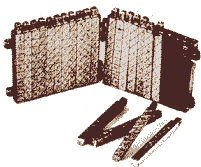 Napier bones |
|||||||||||
| More details can be found in the various sections; just click the hyperlink and use the back button of your browser to return here. | |||||||||||
So far for the artifacts. Yes, they were helpful. But as the quality of life improved, in different parts of the world people started to question themselves and wondered if there was more behind the clouds. And the need for knowledge grew. Scientists of all breeds and colors stepped forward and came with many new findings, inventions and facts of life.
![]() In the Indian
Vedah compiled at least before 6000 BC a verse (Richa) mentions the numerals
of 12 (dwawash), 2 (treemi), and 300 (trishat).
In the Indian
Vedah compiled at least before 6000 BC a verse (Richa) mentions the numerals
of 12 (dwawash), 2 (treemi), and 300 (trishat).
That was one of the earliest recordings of a decimal numeral system. The use of the zero also proved that a 10 based positional numeric system was in use at that time.
It is open to speculation how long before this date the decimal system, inclusive
the zero, was invented.
And, it still leaves us with the question: "who or what people invented
the zero?".

![]() Mathematics
in Egypt is based on the fractional system. A fine illustration of this is found
in the eye of Horus. An egyptian deity of this time. The fractional units were
used to represent the fractions of hekat (appr. 4.8 litres), the unit measure
of capacity for grains. (17)(18) see http://www.greatscott.com/hiero/eye.html
for a great explanation on this form of mathematics.
Mathematics
in Egypt is based on the fractional system. A fine illustration of this is found
in the eye of Horus. An egyptian deity of this time. The fractional units were
used to represent the fractions of hekat (appr. 4.8 litres), the unit measure
of capacity for grains. (17)(18) see http://www.greatscott.com/hiero/eye.html
for a great explanation on this form of mathematics.
See also below at 1850 BC for a riddle in this type of
calculus

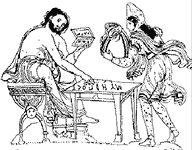
![]() The
Abax (latin), or Abaq (Sumeric), giving the general idea
of an Algorithmic Unit (1)(ALU)
of a computer, is coming in use in the far east. Abaq or Abax stands for dust.
Thus using the Abax or Abaq meant writing in dust.
The
Abax (latin), or Abaq (Sumeric), giving the general idea
of an Algorithmic Unit (1)(ALU)
of a computer, is coming in use in the far east. Abaq or Abax stands for dust.
Thus using the Abax or Abaq meant writing in dust.
The Abax serves as a means to calculate, it is a flat stone or wooden tabletop in which are carved straight lines. Calculations are done using little pebbles, and it is assumed that the various pebbles represent different values. In much later times (approximately 800 AD), the Abax showed up in Europe.
![]() The first
human to actually record numbers in a storage medium may have been a Sumerian
accountant somewhere in the lower Mesopotamian river valley about 3200 BC using
the sexagesimal numbering system based on the numbers 6 and 10. The discovery
of arithmetic brought the Sumerians tangible benefits including the ability
to numerically model the products of their economy, and their commerce grew
making Mesopotamia the creator of Western civilization.(3)
The first
human to actually record numbers in a storage medium may have been a Sumerian
accountant somewhere in the lower Mesopotamian river valley about 3200 BC using
the sexagesimal numbering system based on the numbers 6 and 10. The discovery
of arithmetic brought the Sumerians tangible benefits including the ability
to numerically model the products of their economy, and their commerce grew
making Mesopotamia the creator of Western civilization.(3)
![]() Positional
number system used in Mesopotamia.(5)
Positional
number system used in Mesopotamia.(5)

![]() Early form
of beads on wires, used in China(13)
Early form
of beads on wires, used in China(13)
![]() The Abacus
is described for the first time in Babylon. An improved
version is coming into use around 1300 BC and is still in use now on the Balkan
and Asia.
The Abacus
is described for the first time in Babylon. An improved
version is coming into use around 1300 BC and is still in use now on the Balkan
and Asia.
Just to show how well the abacus is keeping up: in app. 1950 AD, a contest between
man and machine took place and a well trained human still beat the fastest electronic
computer of that day by doing arithmetic on his Abacus.
![]() The Egyptians
came up with the idea of a thinking machine. Citizens went to the "Oracles":
statues in which priests were hidden who communicated via orifices with the
people putting questions to the oracles. This idea was copied in the 18th century
when a smart designer hid a chess player in a so-called
"automatic chess playing machine".
The Egyptians
came up with the idea of a thinking machine. Citizens went to the "Oracles":
statues in which priests were hidden who communicated via orifices with the
people putting questions to the oracles. This idea was copied in the 18th century
when a smart designer hid a chess player in a so-called
"automatic chess playing machine".
![]() Babylonians
used the abacus and approximated pi as 3 1/8.
Babylonians
used the abacus and approximated pi as 3 1/8.
ca. 2000 BCE - Chinese writing system is invented. It was codified around 1500 BCE(16)
![]() Stonehenge
is still a mystery today. Was it a calendar or "just" a place for
spiritual events? Do you want to know more? www.pbs.org
Stonehenge
is still a mystery today. Was it a calendar or "just" a place for
spiritual events? Do you want to know more? www.pbs.org
![]() In the Rhind(8)
Papyrus written by, or copied as he states himself, the Egyptian scribe Ahmes
stated that pi = 256/81 app. 3.160…(5) The scroll
was purchased in Egypt by the Egyptologist Rhind in 1858 and is now in the British
museum of Art.
In the Rhind(8)
Papyrus written by, or copied as he states himself, the Egyptian scribe Ahmes
stated that pi = 256/81 app. 3.160…(5) The scroll
was purchased in Egypt by the Egyptologist Rhind in 1858 and is now in the British
museum of Art.
This scroll contained more than a definition of PI. The Ahmes papyrus contained a set of 84 mathematical problems and their solutions. Although no hint is given how these solutions were arrived at, it gave us an insight into the mathematical knowledge of the early Egyptians.(9)
The Rhind papyrus showed that early Egyptian mathematics was largely based on puzzle type problems. For example the papyrus contained the following puzzle.
Seven houses contain seven cats. Each cat kills seven mice. Each mouse had eaten seven ears of grain. Each ear of grain would have produced seven hekats of wheat. What is the total of all of these?(7)
![]() A well developed
additive number system is now in use in Egypt(5)
A well developed
additive number system is now in use in Egypt(5)
![]() Water
clocks were built in China (1086 by Su Sung, a working model can be seen
in action in Manor Museum UK), Korea (architect:
Chang Yeong Shil, 1438, can still be seen at Kyeong Bok Gung.), Egypt (1500
BC) and in Syria (700 BC). Greece (ca. 5th century BC )
Water
clocks were built in China (1086 by Su Sung, a working model can be seen
in action in Manor Museum UK), Korea (architect:
Chang Yeong Shil, 1438, can still be seen at Kyeong Bok Gung.), Egypt (1500
BC) and in Syria (700 BC). Greece (ca. 5th century BC )
Some examples are shown below.
 Replica of water clock by Su Sung ca. 1086 (courtesy Manor House) |
Chinese water clock
by Su Sung
www.ph.ed.ac.uk |
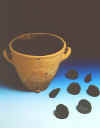
Clepsydra. A unique example of the terra-cotta water
clocks used for counting time of speeches in the public law courts.
Dated to the 5th century BC |
![]() Time and tracking
time was something that intrigued people and would inspire many inventors throughout
the centuries into creating all kinds of clocks. In the 17th century a water
driven clock, the first with hands and all, was constructed.
Time and tracking
time was something that intrigued people and would inspire many inventors throughout
the centuries into creating all kinds of clocks. In the 17th century a water
driven clock, the first with hands and all, was constructed.
And in 1989 a modern water clock was created by French physicist and artist
Bernard Gitton and placed in the children's museum(14).
Water clocks are now mainly used for exploratoria in museums and other than
time keeping purposes.
It was the clock technology would be used to make calculators of many different
shapes. These kind of calculators were made until far into the 20th century.
![]() The Chinese
use of a precision of one decimal is registered. In that the Chinese were calculating
beyond the precision of whole numbers and started to divide the numbers in parts
e.g. fractions.(15)
The Chinese
use of a precision of one decimal is registered. In that the Chinese were calculating
beyond the precision of whole numbers and started to divide the numbers in parts
e.g. fractions.(15)
![]() I-Chin exhibits
binary properties.(5)
I-Chin exhibits
binary properties.(5)
![]() In this century
Pythagoras rediscovered the theorem: the sum of the squares of the sides of
a right triangle equals the square of the hypotenuse.
In this century
Pythagoras rediscovered the theorem: the sum of the squares of the sides of
a right triangle equals the square of the hypotenuse.

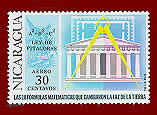
The so-called Pythagorean triples were already known in Babylonian times(2)
![]() Abacus used
in Greece(5)
Abacus used
in Greece(5)
![]() Pythagoras
is credited for a theorem known to the Chinese a thousand years earlier. When
his student Hippasus rediscovered irrational numbers, Pythagoras, believing
the universe to be strictly rational, acts contrarily and has the student drowned
for heresy.(5)(6)
Pythagoras
is credited for a theorem known to the Chinese a thousand years earlier. When
his student Hippasus rediscovered irrational numbers, Pythagoras, believing
the universe to be strictly rational, acts contrarily and has the student drowned
for heresy.(5)(6)
Diophante introduced the equal sign and was the first to use a form of symbolic language of algebra.
![]()
| Last Updated on
August 10, 2004
| For suggestions please mail the editors |
Footnotes & References
| 1. | Algorithmic = calculate, the ALU may be regarded as the computational part of a computer. |
| 2 | Stamp from Maiken Naylor SCI-PHILATELY (http://ublib.buffalo.edu/libraries/units/sel/exhibits/stamps/) |
| 3 | taken from: www.maxframe.com/history.htm |
| 4 | Sarvesh Srivastava at www.geocities.com/dipalsarvesh/mathematics.html 26/09/2001 |
| 5 | www.macmillan online.net Computer Science Timeline |
| 6 | www.macmillan online.net:Hipparcos of Metapontum rediscovers the irrationals but is saved from drowning by clinging to floating-point numbers. 450 BC ?? |
| 7 | http://nova.bsuvc.bsu.edu/home/tmraber/rhind.htm |
| 8 | named after the Scottish Egyptologist Alexander Henry Rhind who went to Thebes for health reasons, became interested in excavating and purchased the papyrus in Egypt in 1858 |
| 9 | http://archive.ncsa.uiuc.edu/Cyberia/VideoTestbed/Projects/Mummy/hieroglyphics.html |
| 10 | http://www.crosscultureinc.com/england.htm |
| 11 | www.cnn.com/2001/TECH/space/ 04/13/big.bang.collision/ |
| 12 | http://members.fortunecity.com/jonhays/tallying.htm |
| 13 | prof Thomas J. Bergin 2001, University of America |
| 14 | http://www.childrensmuseum.org |
| 15 | IDG computer encyclopedia |
| 16 | Georges 1992:45 ref: www.ciolek.com |
| 17 | Eric W. Weisstein et al. "Eye of Horus Fraction." From MathWorld--A Wolfram Web Resource. http://mathworld.wolfram.com/EyeofHorusFraction.html |
| 18 | more on horus' eye: http://www.aloha.net/~hawmtn/horus.htm |